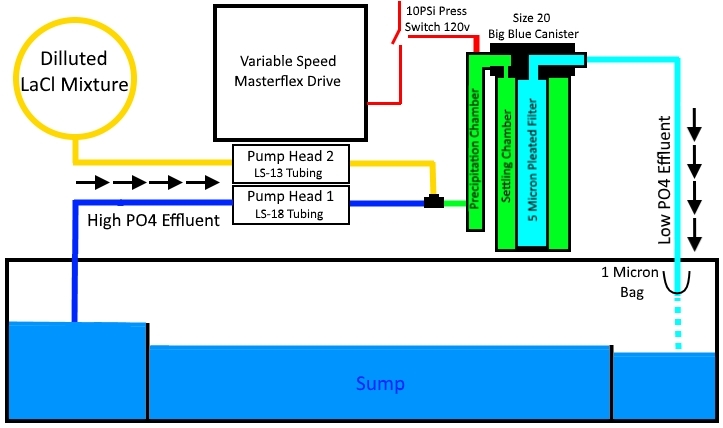This thread will discuss the setup and operation of a Lanthinum Chloride Reactor that I put together a while back. Since its last use I haven't needed it so I shelved work on the project. It was wildly successful and could have some use to others, particularly those with massive setups, and constant phosphate issues so I think it deserves it's own thread.
The great thing about this reactor is that you can easily adjust the rate at which you remove phosphates regardless if you need high rates or low rates of removal. You simply adjust the feed rate of the Masterflex. Like any good piece of hardware that is designed to be a regular part of your filtration setup, it's very low maintenance.
*** There are several different ways to dose LaCl and it isn't something you should just wing. Please, before attempting to dose LaCl, take the time to fully understand Lanthinum Chloride, and how it works in your tank. ***
I originally used this reactor on a large vat of rock I was curing that was heavily bound with phosphates. My goal was to bring the rock down to acceptable nutrient levels without much involved cost or work. This will be first time installing this reactor on a running reef tank.
The concept of this reactor is to mix a continuous ratio of of LaCl with tank water and to do so with a system capable of building significant pressure to avoid filter clogging. This is achieved with a two head Masterflex Continuous Duty Peristaltic pump. One head uses a large tube to push effluent through the reactor while the second head uses a small tube to inject a diluted Lanthinum Chloride mixture. Injecting the LaCl into the stream of effluent causes phosphates to precipitate out of the effluent water. This precipitate is fed into the bottom of a mixing chamber that is full of bio-balls in an effort to get a complete mixing and reaction of the LaCl before it reaches the filtration stage. Some of the precipitate will settle into the bottom of the mixing chamber. The remainder of the precipitation moves into the side 20 Big Blue filter housing that contains a 5 micron pleated sediment filter. The majority of particulates will settle to the bottom of this chamber but the fine particles will be filtered out by the filter. Eventually this filter will clog and need to be cleaned by soaking in vinegar, after soaking for 24 hours and rinsing the filter is as good as new. It should be able to be used many times over. Due to the pressure generated by the Masterflex Peristaltic this filter can last up to 3 months without cleaning. The tubing we are using has a continuous pressure capability of 10psi, therefore we will be using a 10psi pressure switch prior to the filter. This will shut down the pump should the filter clog before regular maintenance has been performed. Without the pressure switch you run a risk of a tubing rupture causing a spill if the filter clogs. In a calcium reactor we typically pull effluent through the reactor but in this situation we need to push through due to the 2nd head pumping LaCl. If there was a clog and we were pulling effluent through the 2nd head would back flow LaCl into the sump. The final step is feed the effluent through a 1 micron filter sock as a precautionary method.
Here is a diagram.

This is a chart I plotted while running the reactor on the bin of rock. Unfortunately the hard drive I was keeping data for the last half of the test crashed and I lost the data. Essentially it continued to reduce phosphates down to less than .05ppm. I plan on doing the same for this test. I use a Hanna 736ulr Phosphorus Checker to test for phosphates.

Pictures of the actual reactor and parts to come as I bring it back online. I dosed my fishless display to kill vermatid snails, flatworms, and aptasia with Chloroquine Phosphate and it left behind a considerable amount of phosphates that I will need to remove before adding SPS to the system.
Thanks for following along, hopefully this helps someone out there.
